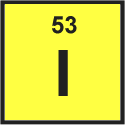Iodine
|
Characteristics and Properties
Under standard conditions iodine is a dark blue-black solid. Iodine crystals can sublimate directly from a solid to a gas. As a gas, iodine is a purple vapor.
Iodine is a fairly active element, but is somewhat less active than the other halogens above it in the periodic table which include bromine, chlorine, and fluorine. Iodine can form compounds with many elements. Some of its most common compounds are formed with sodium and potassium.
Pure iodine can be dangerous to handle causing the skin to burn and damage to the eyes.
Where is it found on Earth?
Iodine is fairly rare, but is found in both the Earth's crust and in ocean water. There is actually a higher concentration of iodine in the ocean than in the Earth's crust. Some ocean plants such as seaweed have a high concentration of iodine. It is also found in underground brines near oil and natural gas reserves.
How is iodine used today?
Iodine has a number of uses. It is used in sanitation systems and as an antiseptic to kill germs and bacteria. It is also used in its radioactive form to enable doctors to diagnose medical issues and diseases.
Other applications include animal feed, cloud seeding, dyes, and photography.
Iodine is also an essential element for life. It plays an important role in the thyroid gland that controls the body's growth rate. Too little iodine can cause a person to have stunted growth and slower cognitive development (less intelligent). To make sure that people get enough iodine, it is often added to salt in what is called iodized salt.
How was it discovered?
Iodine was first discovered and isolated by French chemist Bernard Courtois in 1811. Courtois stumbled across iodine when running experiments on seaweed. It was French chemist Gay-Lussac who first named iodine as a new element and suggested the name.
Where did iodine get its name?
Iodine gets its name from the Greek word "iodes" which means "violet."
Isotopes
Iodine has one stable isotope that occurs naturally, iodine-127.
Interesting Facts about Iodine
- Many people get the iodine they need in their diets from eating seaweed.
- It is the heaviest element that is essential for human life and health.
- Foods rich in iodine include fish, diary products (milk, cheese, yogurt), some fruits and vegetables, and iodized salt.
- Pregnant women need more iodine than the average person. They can get this through dietary supplements.
- Too much iodine is harmful and can make a person very sick. Never take iodine unless instructed by a doctor.

Комментариев нет:
Отправить комментарий